If you’re coming to Lisbon for a vacation but you don’t know how to plan your trip, I’m here to help! One of my friends visited Portugal last month, and I had the chance to create the perfect 6-day itinerary for her. After testing this Lisbon travel plan myself, I can confirm that it’s totally worth it! Join me as I recreate this beautiful journey through the streets of Lisbon.
Day 1 – Lisbon, the Belém Tour

We’ve decided to start our tour with the Belém area. The first stop was going to be Pasteis de Belém, the place where you can taste the real pastel de nata. I must admit – the pasteis de nata there are truly delightful!
Pasteis de Belem
Pasteis de Belém was founded in 1837. Before that, there was a sugar cane refinery in its place attached to a small store. After the Liberal Revolution of 1820, many convents and monasteries were closed, so monks had to find another way to survive – they started selling sweet pastries in the aforementioned shop.
In fact, these pastries now known as pasteis de nata were invented in the 18th century by the Catholic monks at the Jerónimos Monastery, which is close by, so it’s no wonder they relied on their cooking skills to survive!
Over time, the region started attracting visitors who marveled at how amazingly delicious the tart was! Thus, in 1837, Pasteis de Belém opened, and the cooks followed the original secret recipe from the monastery. It had been passed on by the monks to the master confectioners who cooked the pasteis de nata in a secret room.
So, there you have it, the history of this incredible place! You’ll probably notice a very long queue at the entrance – but don’t let this deter you! It’s probably the queue for buying pasteis de nata to go, and even so, you’ll likely spend less than 10 minutes waiting.
If you want table service, you’ll have to go through a different entrance, and there usually is no queue. I certainly recommend choosing table service – not only are the pasteis de nata fresh from the oven but also the cappuccino is absolutely delicious, the best I’ve ever tasted!
Jerónimos Monastery
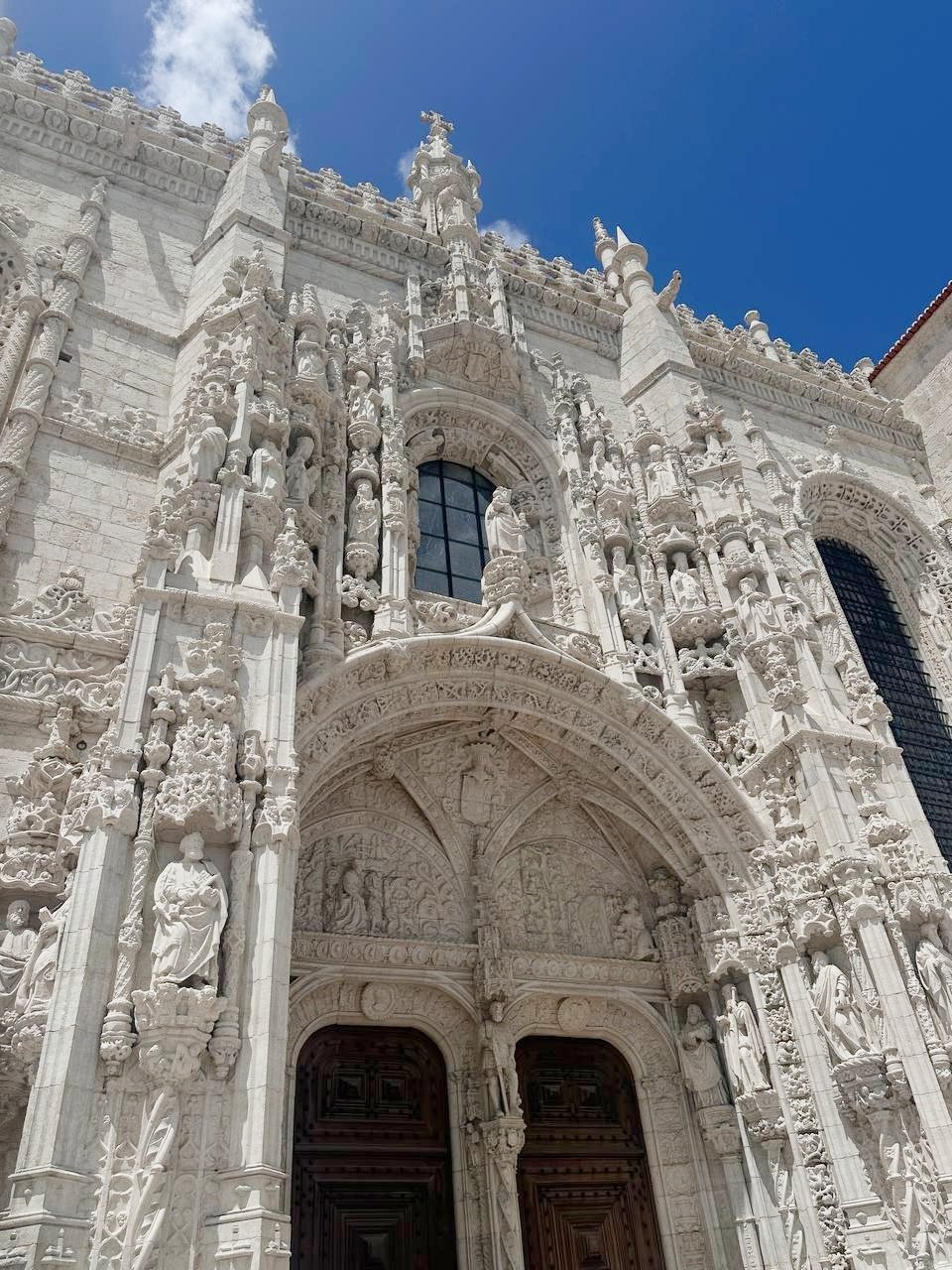
Bellies full and blood sugar levels checked, we headed to the Jerónimos Monastery, which is only two minutes away from the cafe.
It was built at the beginning of the 16th century and is one of the most prominent Manueline buildings in Portugal. It is also the resting place of Vasco da Gama and Luis de Camões.
Again, you’ll likely see a big crowd at the entrance – but don’t let this discourage you because everyone already has tickets, and you won’t spend too much time waiting in line. You can buy tickets on the spot, but we recommend buying them online and using a QR code to enter the monastery. We waited less than 10 minutes, and it was definitely worth it! The church and the cloisters were out-of-this-world! A true architectural gem, without a doubt. And let’s not forget about the exterior and its grand entrances!
The Monument of the Discoveries
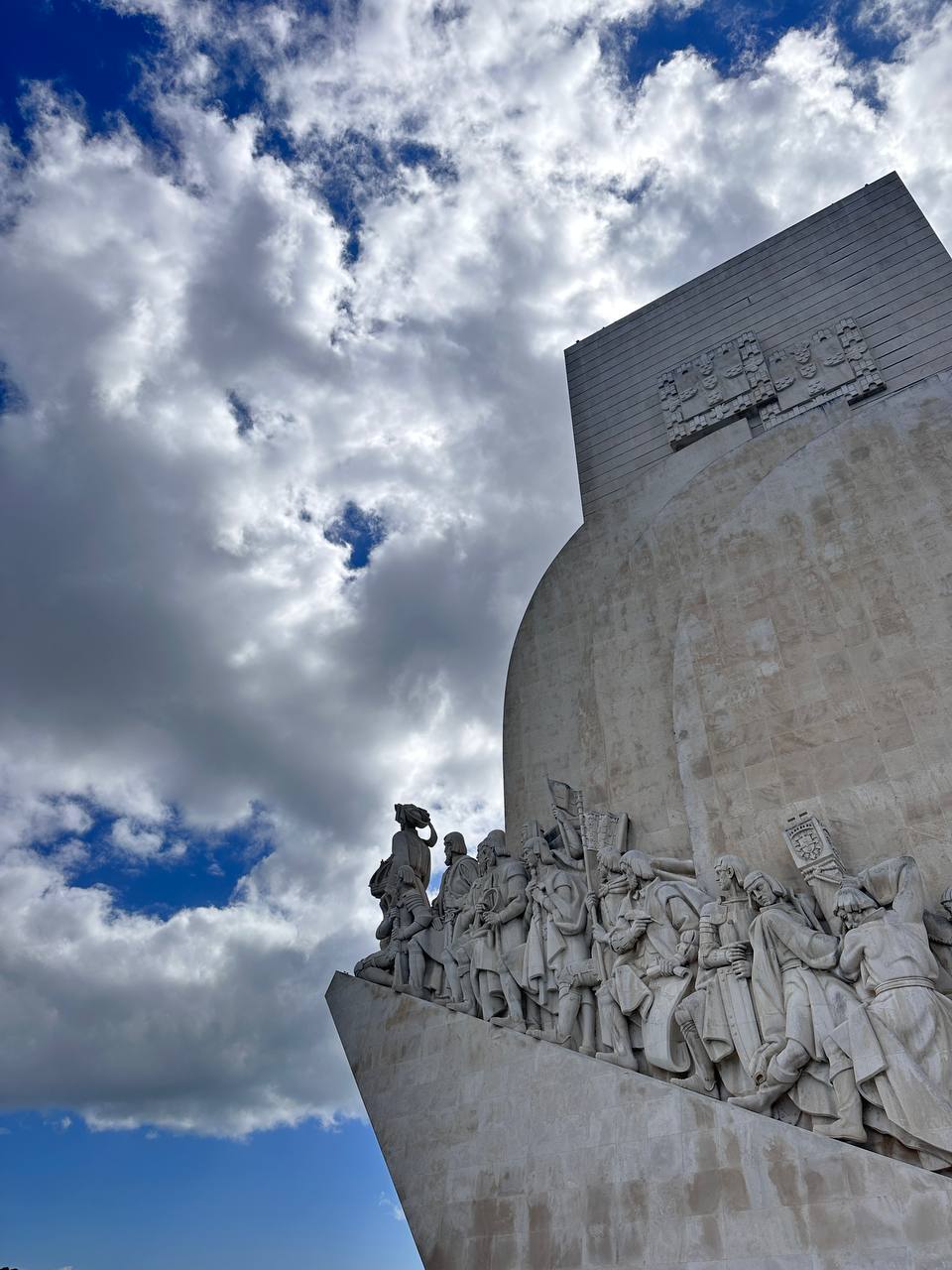
The Monument of the Discoveries was built between 1958 and 1960 to commemorate the death of Henry the Navigator, a central figure in the 15th-century maritime discoveries and expansions.
The monument features the statue of Henry the Navigator holding a carrack and other 33 figures that played an important role in the history of the Discoveries, including Afonso V of Portugal, Pedro Alvares Cabral, Ferdinand Magellan, Afonso de Albuquerque, and Nuno Goncalves, among others.
While the exterior is stunning and will likely amaze you on the spot, you can also visit the interior, which consists of three areas, all of which usually have some exhibitions.
The Belém Tower
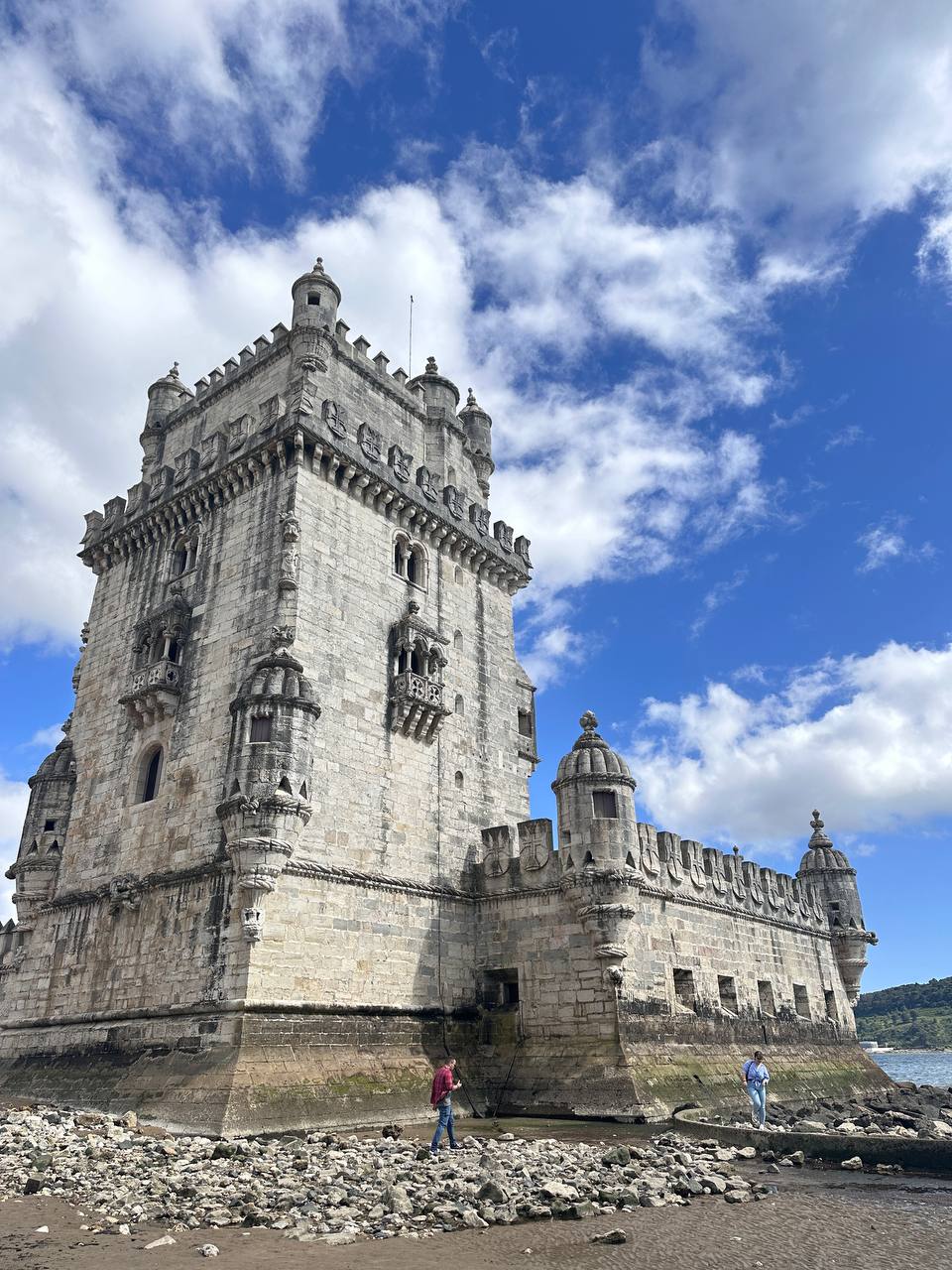
While you’re in the area, you simply cannot miss the Belém Tower – visit it, and you’ll have a full day! Then, you can head toward a restaurant for a well-deserved dinner!
Belém Tower is another iconic Manueline structure. It was built in the 16th century and served as an embarkation and disembarkation point for the Portuguese explorers. In 1983, it was designated a UNESCO World Heritage Site alongside the Jerónimos Monastery.
The exterior is a true Manueline gem with some Moorish influences. The interior has a circular staircase, two contiguous halls with vaulted ceilings, and masonry arches.
Day 2 – Lisbon City Center
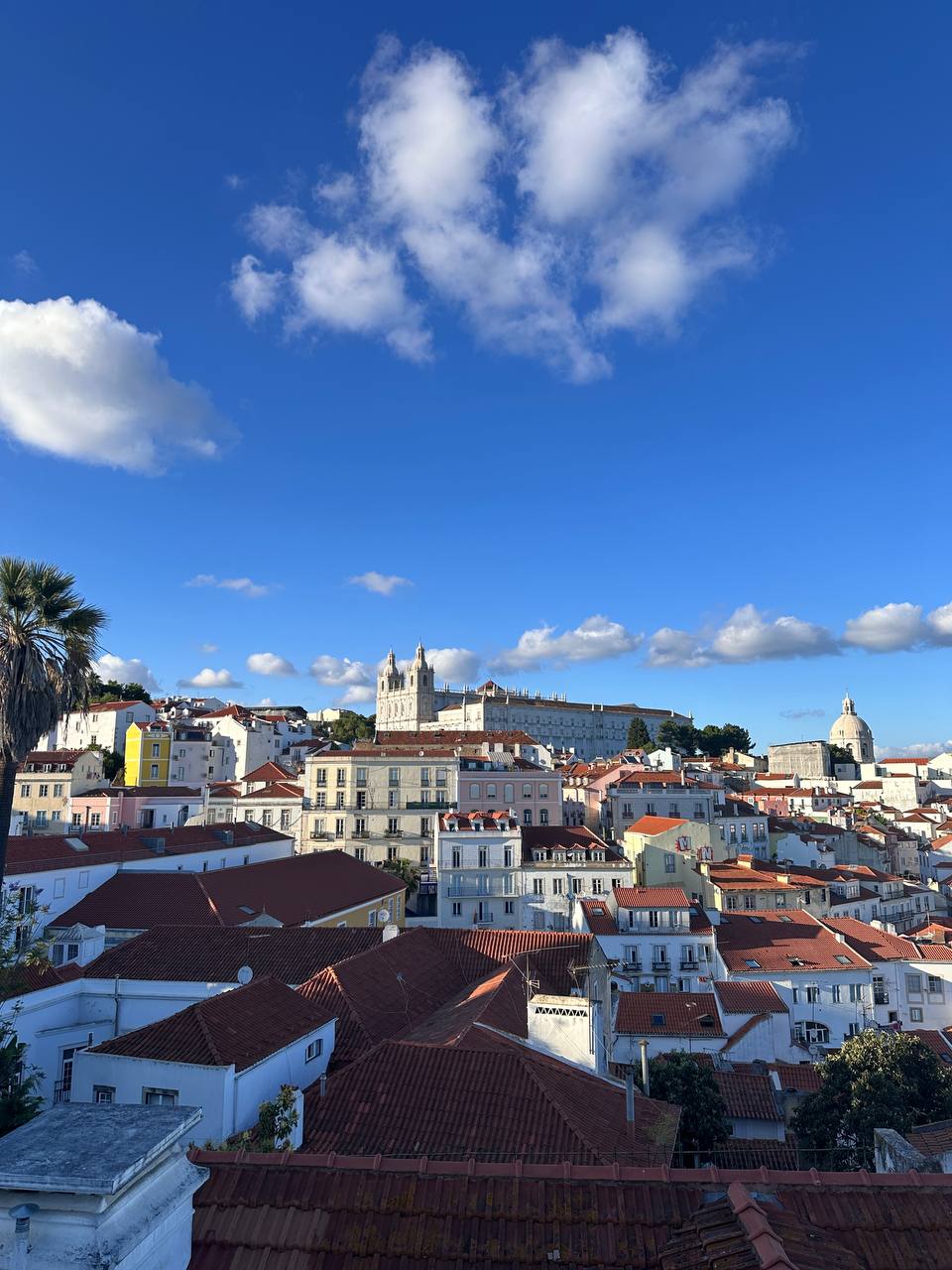
We booked our second day for the Lisbon city center. We first arrived at the Baixa-Chiado metro station and headed straight to Cafe a Brasileira to enjoy a coffee with Fernando Pessoa, one of Portugal’s most famous writers.
Then, we entered Livraria Bertrand, the oldest operating bookstore in the world, and checked out the Elevador de Santa Justa. From there, we walked to Praça Dom Pedro IV to admire the monument and the incredibly beautiful jacarandas.
We then walked to Praça do Comércio on Rua Augusta while admiring the buildings and the artisanal shops. After taking some selfies at Arco da Rua Augusta and enjoying the sun rays in the square, we sat on the steps in front of Cais das Colunas, which is the most notable entrance to Lisbon.
Viewpoints and Churches
Our next stop was Miradouro de Santa Luzia. On our way there, we passed by the Cathedral of Saint Mary Major, also known as Sé de Lisboa. Having been built in 1147 and having survived many earthquakes, it is now the oldest church in the city. It features Romanesque, Gothic, and Baroque architectural elements.
After enjoying the beautiful views at Miradouro de Santa Luzia, we decided to check out another excellent viewpoint – Miradouro da Graça. Although you have to walk approximately 10 minutes (or more because Google Maps doesn’t know how hilly Lisbon is!), it’s totally worth it! The view was incredible, and we also managed to visit the Church of Our Lady of Grace.
While we’re in the region, why not check out the Church and Monastery of São Vicente de Fora as well? It was built in the 17th century and is now one of the most important monasteries in the country. It was originally built in the Romanesque style. Now, it also features Renaissance influences. We did not enter the monastery because it was too late, but we marveled at its exterior!
It may sound like too much to visit in one day, but all the places are close to each other, so I certainly think one day is enough for everything. But you can always adapt the route to your own pace!
Day 3 – Beach Day
After such a busy day in Lisbon, why not have a beach break? After all, Portugal has some of the most stunning beaches in Europe, so adding some to your tour schedule is a must!
We decided to visit Praia de Sesimbra first, which is approximately 35 minutes away from Lisbon by car. If you don’t have a car, you can take an Uber or use public transportation (but you’ll likely have to change the train/bus, as there’s no direct route). While there, you can also explore bits of the city to have a truly authentic experience!
Our next stop was Costa da Caparica, and we were planning to stay there for the rest of the day and enjoy the sunset. It was so worth it! The beaches in Costa da Caparica are truly marvelous – the water is crystal clear, the waves are mesmerizing, and the smell, that pleasant salty ocean smell… a true delight! We spent some time on the beach, watching all those dogs enjoying their time running around in the sand, and then headed to a restaurant to have dinner. After this, we returned to the beach to see the most beautiful sunset we’ve ever seen!
All in all, it was a well-deserved rest day! Now, we’ve recharged our batteries and are up for another full day at Sintra!
Day 4 – Sintra Castles Tour
Before sharing some details about the castles we’ve visited, we must say that one day in Sintra is not enough to check out everything. If you’re on the hunt for castles and historical places, you’ll need two full days in the region. During our one day in Sintra, we only managed to visit the Moorish Castle and the Pena Palace.
The Castle of the Moors
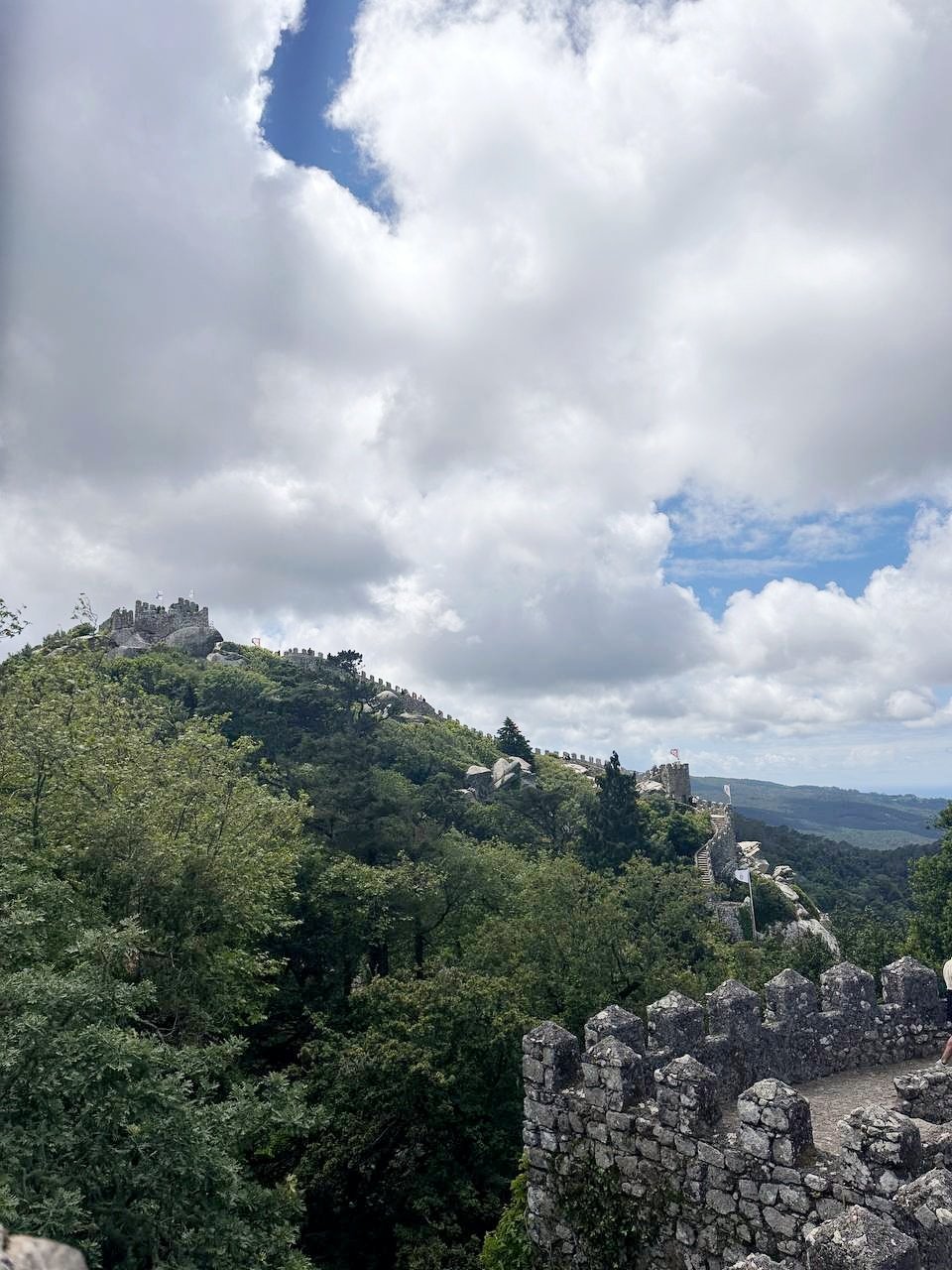
We ended up at the Castle of the Moors by accident. Our first stop should have been Pena Palace. I’ve visited it before and knew that we could buy tickets on the spot but – surprise, surprise – they’ve changed some things, and now you can only buy tickets to enter at a certain hour. The next available tickets were 4 hours later.
So, we had to do something in the meantime. We’d previously visited Quinta da Regaleira, so it was out of the question. Considering that the Castle of the Moors is only 5 minutes away from Pena Palace on foot, we bought tickets and headed straight to the castle.
The Castle of the Moors was built between the 8th and 9th centuries. It became a strategic point during the Reconquista. In 1147, after the fall of Lisbon, the castle was taken by Christian forces. Over the years, the castle suffered considerable damage, particularly after the 1755 Lisbon earthquake. However, many parts of the castle were reconstructed over time.
Since the castle is located on the top of the Sintra Mountains, it offers splendid panoramic views you won’t see anywhere else! However, you may not be so thrilled if you’re afraid of heights – spoiler alert, that’s what happened to me. I was climbing those steps as I’d never climbed steps before just to go back down the stairs as quickly as possible. Nonetheless, I still enjoyed the views and would definitely visit the castle again!
The Pena Palace
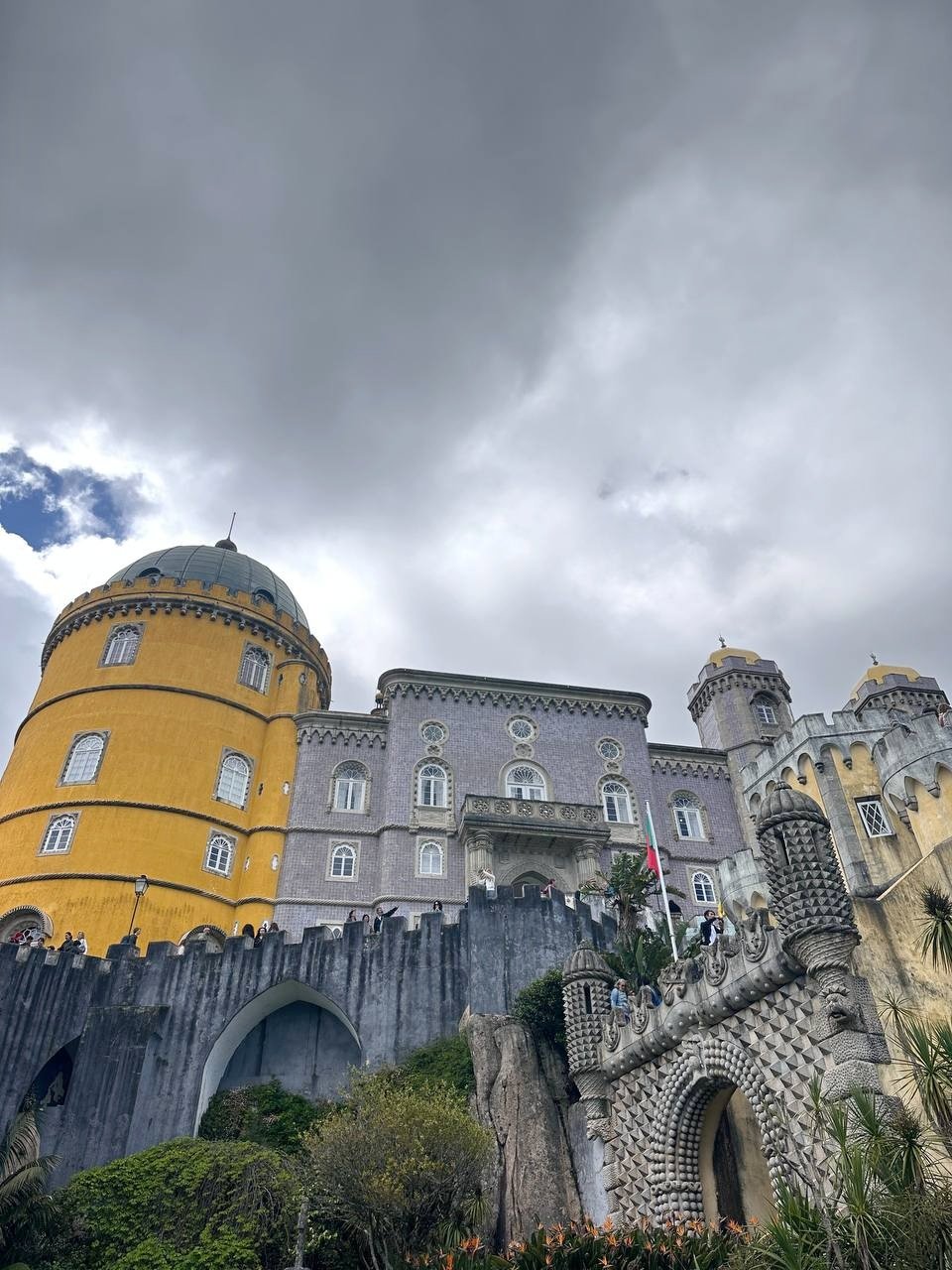
The Pena Palace is definitely the most famous place in Sintra. That’s why I recommend buying tickets a few days before visiting it, especially if it’s peak season.
In short about the castle – although it was officially completed in 1854, the castle’s history goes back to the Middle Ages, when there was just a chapel on the hill top. Years later, King Manuel I ordered the construction of a monastery donated to the Order of Saint Jerome. The place was inhabited by at most 18 monks and served as a meditation place.
However, the 1755 earthquake left the monastery in ruins, and nobody touched them until the middle of the 19th century, when King consort Ferdinand II acquired the territory, as well as the Castle of the Moors, and built the Pena Palace.
The palace was designed by the German architect Wilhelm Ludwig von Eschwege, although Queen Maria II and King Ferdinand contributed to the decorations. For example, the vault arches, as well as the Medieval and Islamic elements were suggested by the King.
As such, the Pena Palace is a combination of Neo-Gothic, Neo-Islamic, Neo-Renaissance, and Neo-Manueline architecture. By far, the most renowned decorative piece is the depiction of the mythological triton on a bay window that symbolizes the allegory of the creation of the world.
Let’s not forget about the park as well, which is an unbelievable haven for any plant enthusiasts or simply those who enjoy spending time in nature!
Other Castles to Visit in Sintra
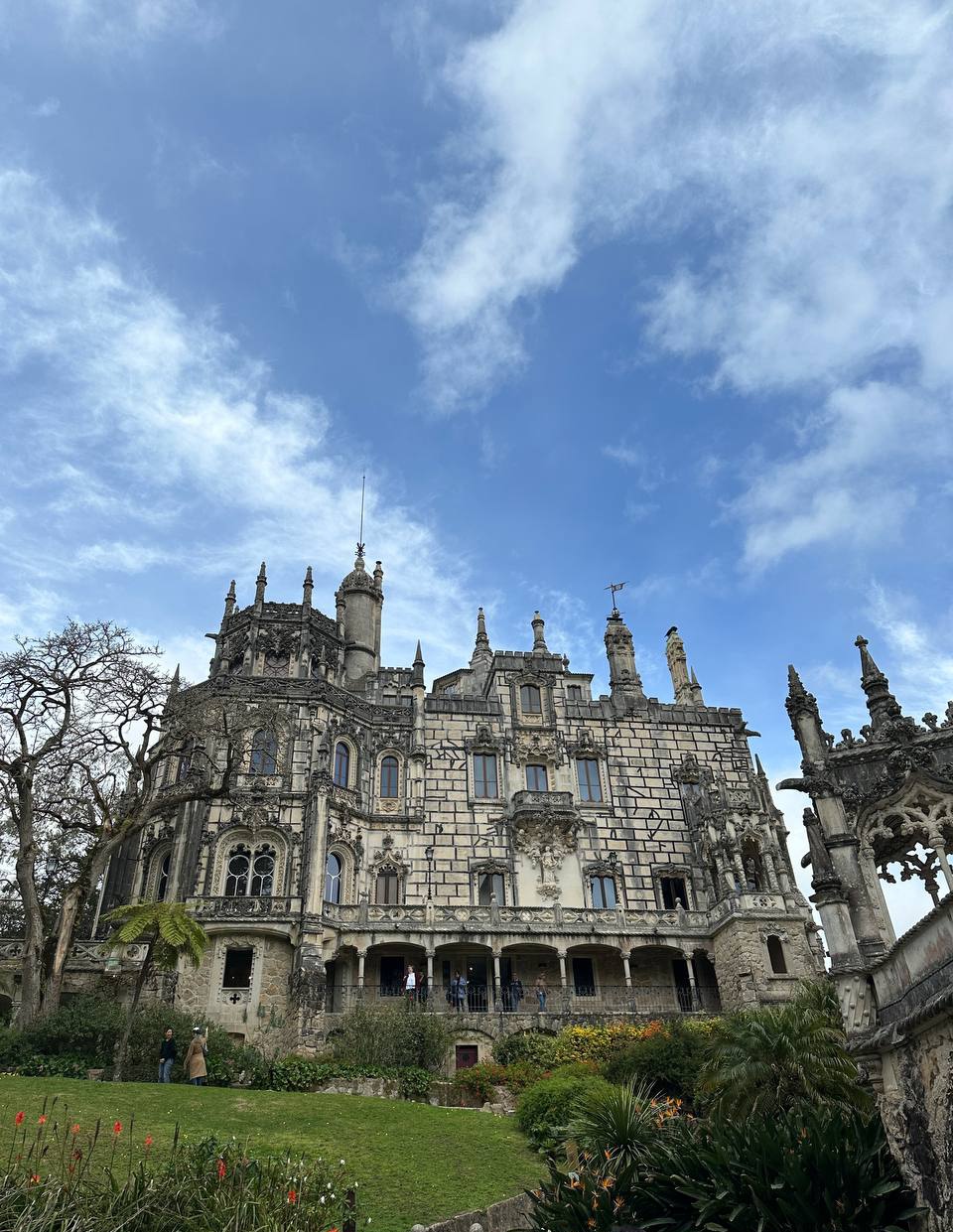
As mentioned, this year we only had time for two castles. However, we definitely recommend giving others a chance as well, especially if you have an extra day you can dedicate to Sintra. Here they are:
- Park and Palace of Monserrate. The palace features Moorish Revival architectural details with some Romanticism influences and neo-Gothic elements.
- The National Palace of Sintra. If you visit the Castle of the Moors, you’ll see the Palace of Sintra from there, standing out among other buildings in the city center. The palace was built in the Middle Ages. It features Gothic, Manueline, Moorish, and Mudejar styles.
- Chalet and Garden of the Countess of Edla. This World Heritage Site is also known as the Casa do Regalo. It was built in the 19th century for King Fernando II and his second wife, Elise, Countess of Edla. Their story is known as Portugal’s greatest love story, so the chalet is definitely a must-visit for couples!
- Convent of the Capuchos. This Franciscan convent is completely different from the other grand structures in Sintra but just as (or even more) charming!
- The Gardens and National Palace of Queluz. This is one of the most luxurious palaces I’ve ever seen, so I definitely recommend visiting it! Have I mentioned that it’s often referred to as the Portuguese Versailles?
- Villa Sassetti. Villa Sassetti isn’t the most famous structure in Sintra but undeniably deserves a visit if you have time for it. It has a circular tower with Romanesque Lombardy elements and terracotta tones. It is hidden within a splendid garden that will take your breath away!
- Quinta da Regaleira. If I were to choose one estate in Sintra that impressed me the most, I’d pick Quinta da Regaleira. The palace is a combination of Roman, Renaissance, Gothic, and Manueline styles, and the garden is a true delight!
- Biester Palace – Right next to Quinta da Regaleira lies another beautiful palace with gorgeous gardens that only opened to the public in 2022. Stop by the cute cafe and have tea in the greenhouse!
Day 5 – Serra da Arrabida and Peninsula de Troia
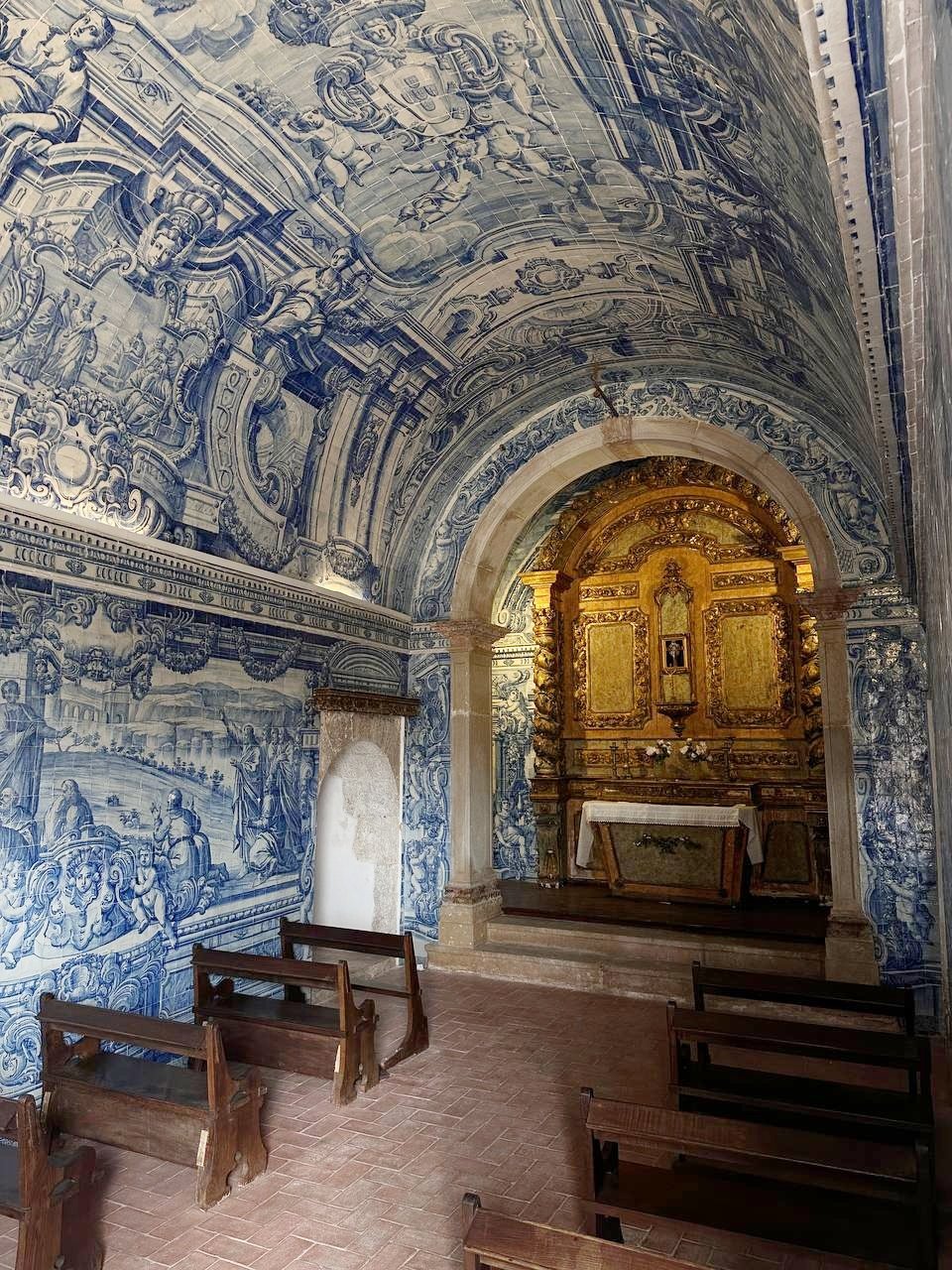
Are you ready for another beach day? Well, this time we’ll also walk around a city, but the final destination is the beach on the Tróia Peninsula for an absolutely stunning sunset!
As such, today we’re heading to Setúbal, a city south of Lisbon and a haven for tourists looking for a quiet vacation by the ocean. The thing is that Setúbal is right near Serra da Arrabida, so you can enjoy a mix of local culture, crystal-clear waters, and majestic nature!
If you want to go around the city, head to Praça do Bocage for a coffee and a walk on Avenida Luisa Todi. Make sure to check out Forte de São Filipe – it has an unbelievably beautiful chapel with azulejo-covered walls. You’ll also delight in amazing panoramic views over the city, the beaches, and the Tróia Peninsula.
In terms of beaches, you can choose among the following:
- Praia de Saúde. It is a small beach but a favorite among locals!
- Praia de Albarquel. It is the closest to the city and can be accessed on foot – the walkway itself offers beautiful views!
- Praia da Figueirinha. This beach is approximately 10 minutes away from the city by car. It’s much larger and has different views.
- The beaches on Tróia. If you’re looking for a less-crowded beach, head straight to Tróia by taking the catamaran from Setubal. It takes only 15 minutes to get there, and you’ll be delighted to have chosen this destination! Although Tróia is mostly a tourist peninsula in the summer and has many restaurants and hotels, it has so many beaches that even in the peak season they’re quite empty! In fact, did you know that the peninsula is the starting point of one of the world’s longest uninterrupted stretches of sand? The beach extends for approximately 40 miles to Sines.
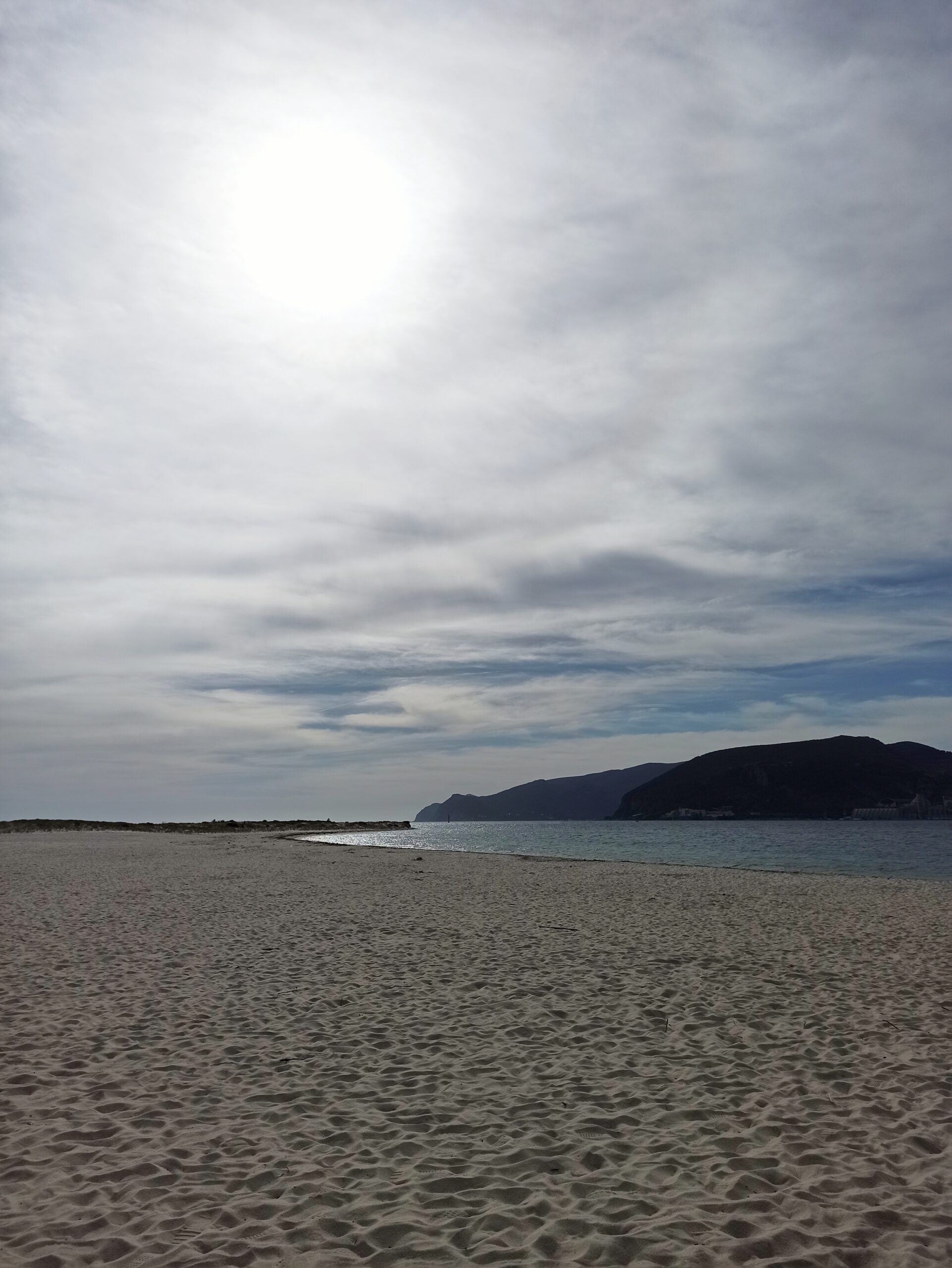
If you’re visiting Setúbal in the summer and want to witness an incredible sunset, we definitely recommend watching it on Tróia. You won’t regret it!
Day 6 – Christ the King and São Jorge Castle

Are you ready for the last day of our trip? Our first stop is Christ the King in Almada, which you most likely have seen from the plane! If you’re coming from Lisbon, just take the Fertagus train to Pragal and then an Uber up to Cristo Rei.
The structure of this monument was inspired by the monument in Rio de Janeiro, Christ the Redeemer. The construction was approved at the beginning of WWII. It was a plea to God to keep Portugal safe from the war. However, the construction began only in 1949 and was finished ten years later. There’s a deck at the base of the statue which offers panoramic views over the 25th of April Bridge, the Tagus River, and Lisbon.
Afterward, we’re heading to Lisbon to visit our last major destination – São Jorge Castle. It stands on a hill, and, over the years, it served as a military barracks, a royal palace, and even the headquarters of the National Archive of Torre de Tombo. The castle is now a national monument and one of Lisbon’s most sought-after tourist destinations thanks to its rich history and incredible architecture.
That’s it! Now, all you’ve got to do is relax! Eat some sardines, drink a glass of wine, ride the 28 tram, have a coffee with some pasteis de nata or other delicious pastries, buy some souvenirs, or check out some parties if you happen to be in Lisbon during the Santo Populares events!
Other Places to Visit in Lisbon
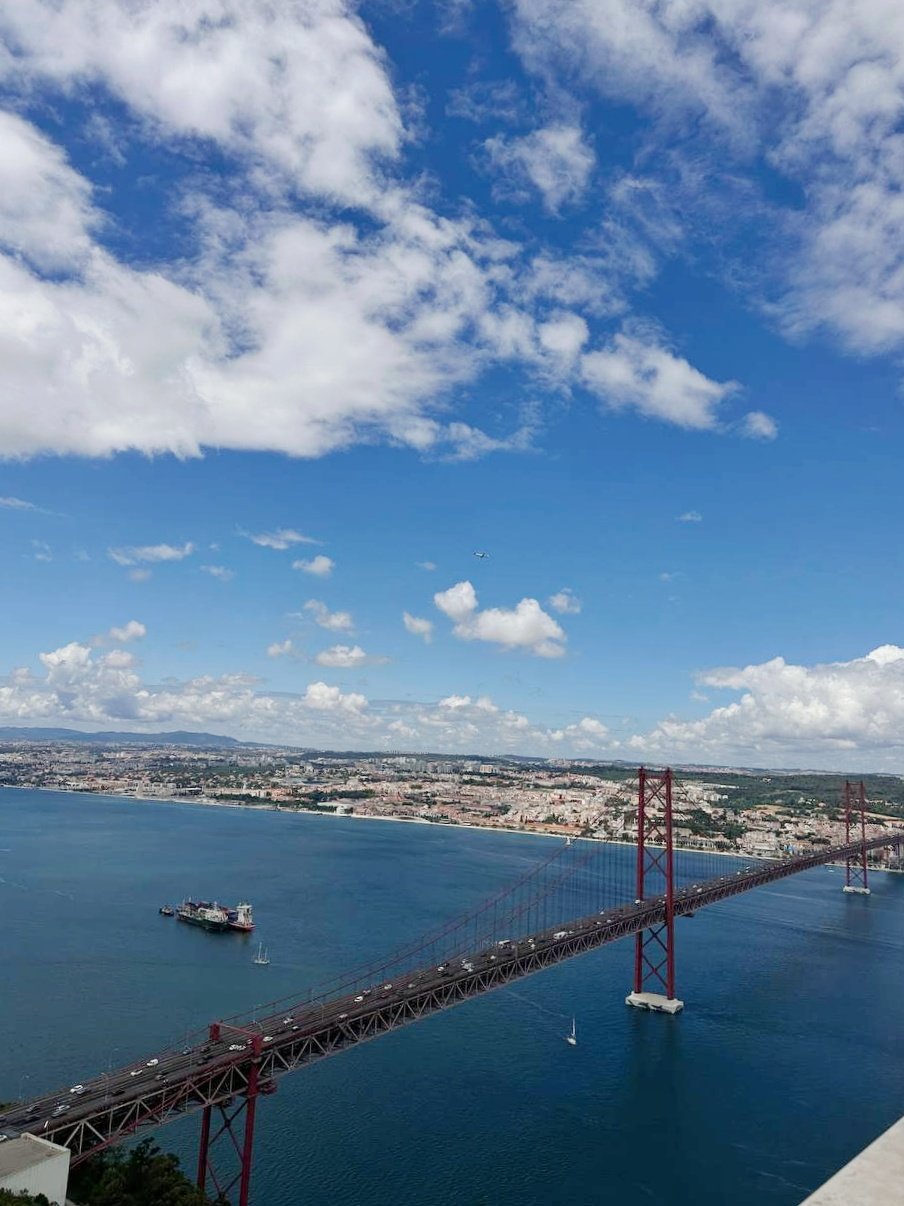
If you’ve planned a longer trip in Lisbon and are looking for some other places to add to your must-visit list, you should consider the following:
- Oceanário de Lisboa. It should definitely be at the top of your list if you’re a wildlife enthusiast and/or are traveling with your kids. They’ll be delighted!
- Telecabine de Lisboa
- The Zoo, another excellent destination for families with kids.
- Miradouro da Senhora do Monte
- National Tile Museum, where you can learn more about Portugal’s most famous art form called azulejo.
- LX Factory, where you can immerse yourself in Lisbon’s cultural universe.
- Calouste Gulbenkian Museum, which has on display one of the world’s largest and most important private art collections – from Ancient Egypt to the 20th century.
- The Museum of Art, Architecture, and Technology
- Panoramico de Monsanto, which offers incredible views and amazing urban art.
- Estufa Fria, a greenhouse you won’t regret visiting!
- Parque Eduardo VII, a large public park in Lisbon with notable vegetation and beautiful views.
- Jardim Botânico Tropical, a wildlife-rich park in Belém close to the Jerónimos Monastery
- Ler Devagar, one of Lisbon’s most famous bookstores.
- Casa Fernando Pessoa, a cultural center in Lisbon and Fernando Pessoa’s house during his last 15 years of life.
- Casa dos Bicos, also known as the Jose Saramago foundation, is a historical house in Lisbon dedicated to the famous Portuguese author, Jose Saramago.
- Panteão Nacional, also known as the Church of Santa Engracia
- Jardim da Estrela, one of the most popular parks in Lisbon
Related Tours
- Book Sunset Walking Tour with Fado Dinner
- Sintra Full-Day Private Tour – A Journey Through Wonderland
- True 4-Hour/Half Day Tuk Tuk Tour of Lisbon
- Bike Tours Lisbon – Center of Lisbon to Belém

